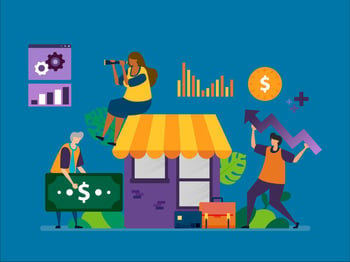Here are insights from the recent Economic Impact report,
What is shaping the ecosystem of small business lending?
There are notable differences and areas of alignment in approaches to global lending for small business. The report – largely informed by a major survey of traditional financial institutions (FIs) and Alt-Fi lenders in North America, Europe, and Australia and New Zealand – will help small business lenders to better understand their markets and to plan ahead.
Business directions
North America, Europe, and Australia and New Zealand differ in the areas they are focusing their businesses.
North American lenders at 47% are placing their “top bet” on business lines of credit.
In Europe, 33% of respondents favor secured loans and 32% of them favor multiple option facilities. In Australia and New Zealand, 29% are focused on unsecured loans and 28% on secured loans.
No matter their lending instrument, lenders increasingly acknowledge the importance of small businesses to domestic economic wellbeing on many levels. FIs, specifically, have learned from the pandemic that small business lending is essential.
In a recent podcast, Q2 VP of Global Sales Greg Demas recently said that he’s now seeing regional FIs “doubling down” on small business lending. He added, “Any bank that wants to be an integral part of their community doesn’t have the option of having a small business arm or not. Small businesses make up the backbone of global communities, whether that's in Europe, Australia and New Zealand, the U.S., or elsewhere. So I think, for any bank that wants to have a community presence, this is a space that they have to play in.”
Innovation preferences
Whether focused on secured, unsecured, or other lending vehicles, lenders consider new technology important to success over the next 24 months. They realize they can shed costs, get to market faster, and open more opportunities.
In North America as well as Australia and New Zealand, 50% identified new technologies as the most important trend impacting their sector. In North America, 50% of the survey respondents specifically cited APIs as having a major role over the next two years. For lenders in Australia and New Zealand, 43% cited cloud-based technologies.
Because European FIs are further out on the tech curve, only 33% of the respondents consider new technology important to success. However, there is more enthusiasm about AI and blockchain: 62% of these lenders believe AI is important, compared to 23% in Australia and New Zealand and 30% in North America, and 44% named blockchain as important moving ahead, compared with 24% of Australia and New Zealand lenders and 25% of U.S. and Canadian lenders.
Commenting on the European survey results, Q2 Managing Direct of EMEA Sales Ian Nelson pointed out that European SME lenders are taking another look at how to serve the marketplace in light of the pandemic and alternative finance’s inroads. He stressed that they’re looking closely at “the cost and lack of process in this space” and “a number of the tier ones are looking at how they can do an element of their SME bank on a straight-through process basis. They can differentiate between straight-through and manual processes, leaving more time for a manual approach in specialized cases.”
Alternative data sets are set for more use
An impressive 84% of lenders believe that using alternative data sets will become the norm in making credit decisions over the next five years. This belief was nearly unanimous among European respondents at 98% and very high in North America at 85%, but slightly less in Australia and New Zealand, where 7% disagreed and 23% were neutral.
One area where alternative data is recognized by respondents as an asset is digital identification, which can be done in a more accurate way by cross-referencing identities across different platforms, in the absence of a centralized digital identity program. This helps to further speed up the credit process and to open the door to marketplace lending for the benefit of a small business.
Another clear takeaway from the growth of alternative data sets is the emerging acceptance of straight-through processing in lending. Automation is and will continue to be a preference when it comes to loan origination in the years to come.
Personalization is a point of focus
Personalization is “vital” to 90% of North American and 93% of European lenders. In Australia and New Zealand, only 28% said so. The higher-trend percentages speak to a growing belief that lenders bringing “high touch” and “high tech” together is a winning strategy moving ahead. One participant pointed out, “We have people in branches who are passionate about supporting small businesses, and they are being empowered by our technological capabilities. That brings the best of both worlds, and I like to call it ‘bionic’ banking.”
Assessing the low survey response to the importance of personalization in Australia and New Zealand, Q2 Director of Sales Excellence, APAC Sales, Ali Khan believes the statistic doesn’t fully convey the positive CX change taking place. He pointed out, “There are examples where traditional banks have shut down branches and set up small centers which provide digital output for clients, providing a digital experience so to speak. Much like you would have with the Apple Smart Bar, where you go in, take your laptop, and they give you some advice about it. So, the whole ‘human plus technology’ element is really tied into it.”
Ecosystem thinking takes charge
The majority of lenders – including both older and newer ones – believe ecosystem thinking will support financial growth. More than 76% of lenders worldwide agreed that ecosystem thinking based on partnerships between incumbents, fintechs, and big-tech firms is “the way forward” for small-business lending.
There is a growing realization that financial services organizations can continue to compete against each other and at the same time, partner to increase accessibility and inclusion and help the small-business sector power the post-COVID economic recovery. In the process, revenue opportunities increase, offsetting concerns over the low rates and profit margins many associate with small-business lending.
Listen to our podcast SMB Lending: What The Economist’s Survey Says and hear more from Q2’s Greg Demas, Ian Nelson, and Ali Khan about the report findings on small business lending.
And also make sure to download our infographic highlighting the Economic Impact report’s global and regional highlights.




